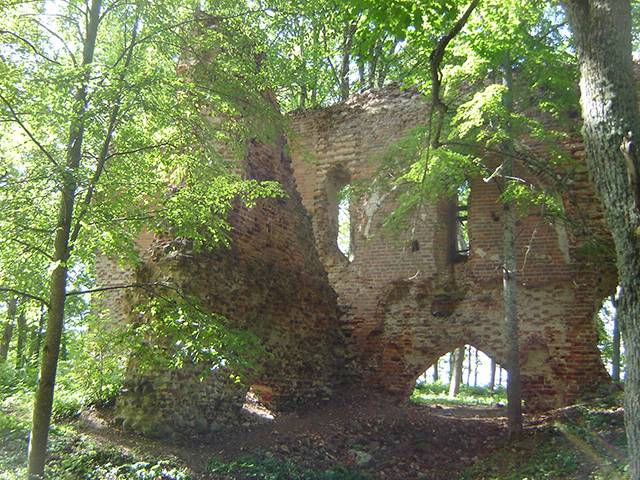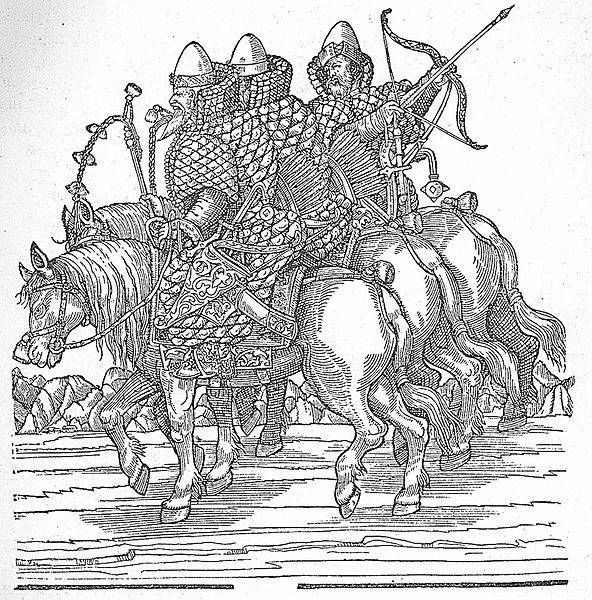Heroic defense of Ringen
prehistory
The beginning of the Livonian war was extremely successful for Russia. During May-July 1558, the Russian army was able to besiege and take Narva (Rugodiv) and Dorpat (Yuriev). Among a significant number of other castles and fortresses Ringen (Ryngol) was taken, where a small garrison was left. The discharge book reports only 40 children of boyars and 50 archers (along with the servants of all Russians there were 140 people, according to Livonian data, there were more 400 Russians in the castle). The main part of the Russian army moved into the borders of Russia to “winter apartments”.
While the Russians were celebrating the victory, sharing the loot, and leaving a few garrisons in the towns and castles they took, they went on a winter holiday, preparing for a new campaign, the Livonians were preparing for a counterattack. The master of the order V. von Fürstenberg, his deputy G. Kettler (the aged master acted passively during the Russian offensive, prepared the counterattack, therefore Kettler led the order troops), the Riga archbishop Wilhelm and the commander of the Riga archbishopric F. von Felkersz began in the summer XNUM . Gunpowder and lead were transported from the Hanseatic cities in Livonia. In Germany, hired several thousand mercenaries - Reiter and bollards. Closer to the front line, food, fodder and other supplies were brought.
As a result, the Livonians prepared the army for a counterattack. Ketler's troops included 2 thousand cavalry, 7 thousand knights (infantry) and 10 thousand militia (according to other sources, 4 thousand cavalry, 4 - 7 thousand infantry). Russian sources reported that there were more than 10 thousand warriors with the master. Thus, the Livonians prepared about 10 thousand or even more professional warriors. In Europe at that time it was a serious army. A lot of money was required to collect and maintain such a number of reiter and landsknechts. A worthy task was needed for her - the Livonians planned to repel Yuryev. At the same time, the Livonian military leader did not include artillery in his army, hoping to take the city with the help of surprise and the help of loyal citizens. Located on the outskirts of Dorpat, the small Ringen fortress was planned to be taken straight off.
The preparation of the Livonians for the counteroffensive for the Russian command remained unknown, as was the beginning of the enemy offensive. The Russians believed that the enemy was utterly defeated and no longer able to counterattack. At that time, small Russian detachments continued raids, seized small castles, settlements, and swore local “black people” to the sovereign. So, in August 1558 of the year, according to Voivodeship reports, Wesenberg (Rakovor), Borholm (Porhol), Lais (Laus), Tolsburg (Thickness), Poddes and Adsel were taken, at the end of September - Kavelekht (Kinevel) and Operpalen (Polchev) . Small Russian forces successfully devastated the neighborhood of Revel-Kolyvan itself. Thus, it seemed that the enemy was defeated and there was no need to expect any trouble on his part.

Ruins of Ringen Castle
Defense Ringen
26 September 1558, Kettler with advanced forces made from Volmar and October 1 came to Ringen. Apparently, at the same time, the commander of the garrison, Rusin Ignatiev, sent a messenger to Dorpat to the local governor with disturbing news. After receiving news of the enemy offensive, Prince DI Kurlyatev sent a messenger to Moscow. Meanwhile, on October 4, Ringen from the south approached, from Schwanenburg, with 600 riders and 3 thousand infantry (mostly Oppel) Felkers. Obviously, the Livonians were planning that the small Russian garrison would quickly capitulate and they would be able to go to Dorpat on the move and take it with the help of the “fifth column” inside the city.
However, the garrison Rusin Ignatieff refused to surrender and sat under the siege. Leave a small but brave Russian detachment in the rear, the Livonian command did not dare and was forced to begin the siege of the fortress. And for the correct siege, additional forces were needed, and above all - siege, heavy artillery, which Kettler did not have. A message was sent to Wenden, to the master, requesting the sending of reinforcements and artillery. In turn, Felkersham sent a messenger for heavy artillery in Dyunymunde. October 6 1558 of the year Furstenberg sent Kettler about 1 thousand knights, several hundred horsemen and artillery. But while they get to the deputy master Kettler by the blurred autumn rains and take up their destructive work, not much time has passed. And it was on hand Russian. The plan for a surprise attack on Dorpta was foiled.
At this time, while the Livonians were strengthening under Ringen, the Russians began to organize a repulse against the enemy. In early October, a messenger arrived in Moscow to the tsar Ivan Vasilyevich, they were aboard the Yurievskogo governor Kurlyatev. The voivode wrote that "the Maistre gathered and the artispkup with all the people and the Overseas people came with them to Ryngol town." Also, the Yuriev voevode perpetrated a search in the city to catch the "maister" benifits and sent intelligence to Ringen in order to capture the "languages" and establish permanent monitoring of the enemy's actions. Yuriev hastily prepared for the siege.
In the capital, the news of the enemy offensive boomed like a bolt from the blue. Not so long ago, they celebrated victory over the enemy, handed out awards, victorious messages from successful Russian detachments continued to be received from Livonia, and suddenly such an unpleasant surprise from the seemingly completely defeated and demoralized enemy. To repel the Livonians and the de-blocking of Ringen, they began to gather an army, it was supposed to be headed by the seaside voivod Prince MP Repnin (the formal commander was Prince Ivan Cherkassky). In Moscow, they did not dare to remove people from the garrisons of the Livonian city and castles taken in the summer - early autumn 1558 of the year, confining themselves to collecting people from Pskovshchyna and Shelonskoy Pyatina - directly adjacent to the combat area. In total, about 1 thousand servants of Tatars and Cherkasy, more than 1 thousand Pskov and Sheleons landowners gathered. This made it possible to accelerate the mobilization and collection of troops, but limited the combat capabilities of the governor. With such small forces, without infantry and artillery, they could only wage a “small” war, disturbing the rear of the enemy army and not being able to defeat Kettler and force him to lift the siege.
It is not entirely clear why such a small and weak detachment was directed against the enemy. Apparently, either the Yurievsk voivode Kurlyatev did not report the size of the enemy army to the capital or the Russian government underestimated the enemy. As a result, 8-ths. Were sent against 10 - 2 thousand of the Livonian army with professional cavalry, cavalry and artillery. Light horse Russian army. It is not surprising that when a two-thousand detachment of voivode Mikhail Repnin, hastily assembled in Pskov and Novgorod, tried to break through to the besieged, he failed. Without infantry and artillery, the Russian cavalry could not storm the well-fortified camp of the enemy (the master “dug in a great moat and turned round around”). The Russian commanders could only “pinch” the Livonians, hoping that Kettler, angry, would send part of his forces to destroy the enemy unit. However, all attempts by the governor to force the enemy to accept the "direct cause" were not successful Kettler did not take risks, waiting for new reinforcements and artillery.
By October 11 1558, the Livonians, having received reinforcements, securely besieged Ringen. Waited for the arrival of the siege artillery. At this time, the Livonians fired at the castle of light cannons and fired from besieged from the arquebus. “Maistre beats around the city and proceeds to Ringol every day,” wrote the chronicler, retelling the voivodship formal replies, “And Rusin Ignatiev in fights they beat people, and along with the maister many ...”. Of course, the voivode was exaggerated. If the Livonian army immediately had siege artillery - a “big outfit”, then a small garrison would have to quickly lay down weapon before the threat of complete destruction of the walls, or with honor to die on the ruins of the castle.
October 22 under Ringen delivered heavy artillery. Livonians installed guns and immediately opened fire. The old walls of the fortress were badly damaged. After that, the Livonians went to the assault. They managed to break into the castle and captured several prisoners, but Ringen’s defenders, according to Livonian chronicler Renner, were ready to be buried under the castle ruins, but did not surrender, stood to the death and threw the enemy away. Pissed off with failure, Magister Furstenberg ordered the prisoners sent to him to be hanged, in retaliation for those executed by Kurlyatev on suspicion of spying Dorpat citizens.
The reflection of the October 22 assault was the last success of the people of Rusin Ignatiev. The garrison in the battles suffered serious losses - no less than a third, perhaps more, of the initial composition. 29 - October 30 1558, after several days of continuous shelling, the Livonians again went on Ringen’s decisive assault. This time the assault was successful. Livonians were able to break into the castle and kill his defenders. According to the Livonian data, 50 prisoners of defenders were hanged, another 95 man, among whom was a noble boyar (apparently Rusin Ignatiev) with his son, was sent to Venden to see the master. Of fate was no less sad. Prisoners and the Ringen "captain" (Rusin Ignatiev) were thrown into dungeons and "sleek and ridiculous in winter."
However, their death was not in vain. The plan of the Livonian military-political leadership on the move to take Derpt-Yuryev was not successful. Having spent more than a month on Ringen, the Livonian army, due to the loss of the surprise factor and the onset of cold weather, was unable to build on its success and continue the planned campaign. Leaving Ringen, Kettler retreated to Riga. The Livonians were only able to push back the Repnin detachment and raid the Pskov frontier. The Russian command immediately struck back. Angry at the fall of Ringen, Tsar Ivan the Terrible ordered to organize a winter hike to Livonia.
Already in January, 1559, the royal army led by Prince S. I. Mikulinsky, mercilessly devastated the land of the Riga archdiocese and the Order. At the same time, the Advanced Regiment of the Russian troops, led by commander Vasily Serebryanny-Obolensky, defeated a large detachment of the Livonian Order, led by the knight Friedrich von Velkerzam, in the Battle of Tierzen. The battle fell 400 knights, including the Felkers himself. Much of the Livonian army captured. After this victory, the Russian army raided the lands of the Livonian Order all the way to Riga, where the Livonian fleet was able to burn. In February, the army returned to the borders of the Russian kingdom with a huge booty and a large number of prisoners.

Russian horsemen. German engraving. German edition of Herberstein
Information